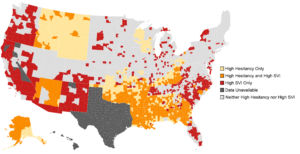Approximately one million excess deaths have occurred since the start of the coronavirus pandemic– a heavy burden, and not just for those considered at highest risk. We estimate the average person who has died since the start of the pandemic lost 13.5 years of life, a statistic that has increased as the second year of the pandemic inflicted more losses on younger adults. In total, life years lost from pre-mature mortality amount to 13.5 million.
In this analysis, we extend our previously published work examining the years of life lost in the U.S. during the COVID-19 pandemic to include all excess deaths from March of 2020 through January of 2022. Since the Spring of 2021 (when our last analysis concluded), several major events occurred: access to vaccines became relatively widespread and the delta and omicron variants spread through partially unvaccinated communities.
Excess deaths and life years lost
For one million excess deaths, we estimate that 13.5 million life-years have been lost.
Although individuals over the age of 65 make up the majority of deaths, the burden in years of life lost is shared by individuals of all ages. Adults younger than 65 years old made up 56% of life years lost. When younger adults die, they lose more potential years than an older person. As you can see in the figure above, someone in the 25-34 age bracket who dies loses an average of 46.7 years of life. In comparison, a 75-year-old who dies loses an average of 7.7 years of life. Total deaths have been much greater among the oldest old, but the burden in years of life lost is nearly double for the younger group.
Stark disparities by race and ethnicity
There have been large disparities between races/ethnicities during the pandemic with minority populations of all ages experiencing a higher burden than non-Hispanic whites.
For example, Hispanics ages 85 and older experienced 2,150 excess deaths per 10,000. This is in sharp contrast to white individuals in the same age bracket who experienced under 1,000 excess deaths per 10,000.
Despite a relatively large increase in deaths among young non-Hispanic whites in the past 10 months, disparities continue to exist. Since March of 2021, all race/ethnicities have experienced increases in the average years of life lost.
In our previous analysis through March of 2021, the average individual who died lost 12.3 years of life. Since then, deaths have shifted to younger individuals. Consequently, the average years of life lost for each decedent are now 13.5 years of life. Across race/ethnicity, we find that Hispanics have lost 17.4 years of life, non-Hispanic Blacks have lost 14.7 years of life, and non-Hispanic Whites have lost 12.2 years of life.
Methods
We focus on excess deaths during the pandemic, from both COVID-19 and other causes to capture the full mortality impact of COVID-19. We use a dynamic simulation model to project how long individuals would likely have lived had they not died of COVID-19 or other causes. From this, we produce estimates of years of life lost (YLL) by age groups, race/ethnicity, and gender. This measure allows us to understand the burden COVID-19 has had on younger adults. While it is true that the virus has killed many more adults 75 and older who may have been closer to the end of their lives, younger people who died would have had many more years to live. By quantifying these years, we can have a fuller picture of the burden of the pandemic. Briefly, we rely on the models to project a world without COVID-19. For ages 25-54 we use the Future Adult Model (FAM), which is based on data from the Panel Study of Income Dynamics. For those aged 55 and older we use the Future Elderly Model (FEM), which relies on data from the Health and Retirement Study. Both FAM and FEM are extensively validated models that project health risk factors, chronic health conditions, functional limitations, nursing home entry, and mortality. To assess the excess deaths during the COVID-19 pandemic, we combine characteristics of individuals in FAM/FEM with data on mortality from CDC and CMS, and data on risk factors from Bhaskaran et al (2021). More details are available in the peer-reviewed publication. For the analysis of 1 million excess deaths, we use the distribution of COVID and excess deaths by age, race/ethnicity and gender from mortality data between 03/01/2020 - 12/18/21, and scale it to a total of 1 million excess deaths.
Sign up for Schaeffer Center news



